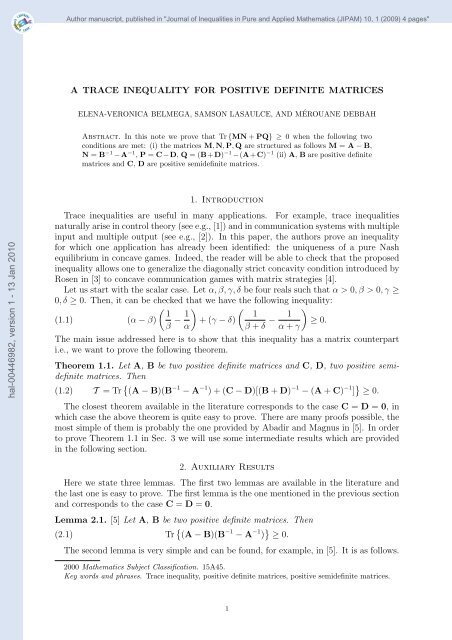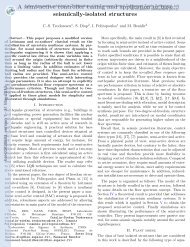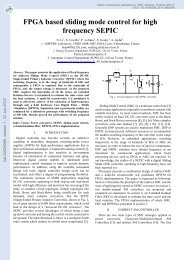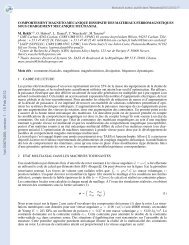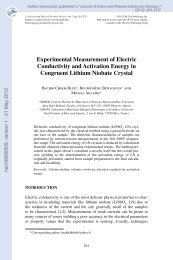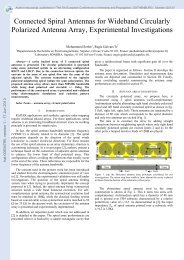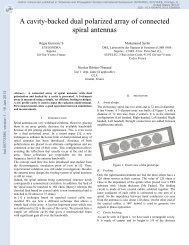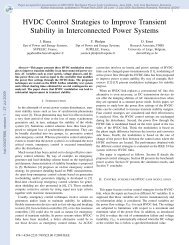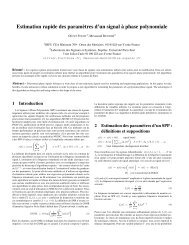A TRACE INEQUALITY FOR POSITIVE DEFINITE MATRICES
A TRACE INEQUALITY FOR POSITIVE DEFINITE MATRICES
A TRACE INEQUALITY FOR POSITIVE DEFINITE MATRICES
You also want an ePaper? Increase the reach of your titles
YUMPU automatically turns print PDFs into web optimized ePapers that Google loves.
Author manuscript, published in "Journal of Inequalities in Pure and Applied Mathematics (JIPAM) 10, 1 (2009) 4 pages"<br />
A <strong>TRACE</strong> <strong>INEQUALITY</strong> <strong>FOR</strong> <strong>POSITIVE</strong> <strong>DEFINITE</strong> <strong>MATRICES</strong><br />
ELENA-VERONICA BELMEGA, SAMSON LASAULCE, AND MÉROUANE DEBBAH<br />
Abstract. In this note we prove that Tr {MN + PQ} ≥ 0 when the following two<br />
conditions are met: (i) the matrices M, N, P, Q are structured as follows M = A − B,<br />
N = B −1 −A −1 , P = C−D, Q = (B+D) −1 −(A+C) −1 (ii) A, B are positive definite<br />
matrices and C, D are positive semidefinite matrices.<br />
hal-00446982, version 1 - 13 Jan 2010<br />
1. Introduction<br />
Trace inequalities are useful in many applications. For example, trace inequalities<br />
naturally arise in control theory (see e.g., [1]) and in communication systems with multiple<br />
input and multiple output (see e.g., [2]). In this paper, the authors prove an inequality<br />
for which one application has already been identified: the uniqueness of a pure Nash<br />
equilibrium in concave games. Indeed, the reader will be able to check that the proposed<br />
inequality allows one to generalize the diagonally strict concavity condition introduced by<br />
Rosen in [3] to concave communication games with matrix strategies [4].<br />
Let us start with the scalar case. Let α, β, γ, δ be four reals such that α > 0, β > 0, γ ≥<br />
0, δ ≥ 0. Then, it can be checked that we have the following inequality:<br />
( 1<br />
(1.1) (α − β)<br />
β α)<br />
− 1 ( 1<br />
+ (γ − δ)<br />
β + δ − 1 )<br />
≥ 0.<br />
α + γ<br />
The main issue addressed here is to show that this inequality has a matrix counterpart<br />
i.e., we want to prove the following theorem.<br />
Theorem 1.1. Let A, B be two positive definite matrices and C, D, two positive semidefinite<br />
matrices. Then<br />
(1.2) T = Tr { (A − B)(B −1 − A −1 ) + (C − D)[(B + D) −1 − (A + C) −1 ] } ≥ 0.<br />
The closest theorem available in the literature corresponds to the case C = D = 0, in<br />
which case the above theorem is quite easy to prove. There are many proofs possible, the<br />
most simple of them is probably the one provided by Abadir and Magnus in [5]. In order<br />
to prove Theorem 1.1 in Sec. 3 we will use some intermediate results which are provided<br />
in the following section.<br />
2. Auxiliary Results<br />
Here we state three lemmas. The first two lemmas are available in the literature and<br />
the last one is easy to prove. The first lemma is the one mentioned in the previous section<br />
and corresponds to the case C = D = 0.<br />
Lemma 2.1. [5] Let A, B be two positive definite matrices. Then<br />
(2.1) Tr { (A − B)(B −1 − A −1 ) } ≥ 0.<br />
The second lemma is very simple and can be found, for example, in [5]. It is as follows.<br />
2000 Mathematics Subject Classification. 15A45.<br />
Key words and phrases. Trace inequality, positive definite matrices, positive semidefinite matrices.<br />
1
2 ELENA-VERONICA BELMEGA, SAMSON LASAULCE, AND MÉROUANE DEBBAH<br />
Lemma 2.2. [5] Let M and N be two positive semidefinite matrices. Then<br />
(2.2) Tr{MN} ≥ 0.<br />
At last, we will need the following result.<br />
Lemma 2.3. Let A, B be two positive definite matrices, C, D, two positive semidefinite<br />
matrices whereas X is only assumed to be Hermitian. Then<br />
(2.3) Tr { XA −1 XB −1} − Tr { X(A + C) −1 X(B + D) −1} ≥ 0.<br />
Proof. First note that A + C ≽ A implies (see e.g., [6]) that A −1 ≽ (A + C) −1 ≽ 0 and<br />
that A −1 − (A + C) −1 ≽ 0. In a similar way we have B −1 − (B + D) −1 ≽ 0. Therefore<br />
we obtain the following two inequalities:<br />
hal-00446982, version 1 - 13 Jan 2010<br />
(2.4)<br />
Tr {XA −1 XB −1 }<br />
Tr {A −1 X(B + D) −1 X}<br />
(a)<br />
≥ Tr {XA −1 X(B + D) −1 }<br />
(b)<br />
≥ Tr {(A + C) −1 X(B + D) −1 X}<br />
where (a) follows by applying Lemma 2.2 with M = XA −1 X and N = B −1 −(B+D) −1 ≽<br />
0 and (b) follows by applying the same lemma with M = A −1 − (A + C) −1 ≽ 0 and N =<br />
X(B + D) −1 X. Using the fact that Tr {XA −1 X(B + D) −1 } = Tr {A −1 X(B + D) −1 X}<br />
we obtain the desired result.<br />
□<br />
3. Proof of Theorem 1.1<br />
Let us define the auxiliary quantities T 1 and T 2 as T 1 Tr {(A − B)(B −1 − A −1 )}<br />
and T 2 Tr {(C − D)[(B + D) −1 − (A + C) −1 ]}. Assuming T 2 ≥ 0 directly implies that<br />
T = T 1 + T 2 ≥ 0 since T 1 is always non-negative after Lemma 2.1. As a consequence, we<br />
will only consider, from now on, the non-trivial case where T 2 < 0 (Assumption (A)).<br />
First we rewrite T as:<br />
(3.1)<br />
T = Tr {(A − B)(B −1 − A −1 )} + Tr {[(A + C) − (B + D)][(B + D) −1 − (A + C) −1 ]} −<br />
Tr {(A − B)[(B + D) −1 − (A + C) −1 ]}<br />
(c)<br />
≥ Tr {(A − B)(B −1 − A −1 )} − Tr {(A − B)[(B + D) −1 − (A + C) −1 ]}<br />
= Tr {(A − B)B −1 (A − B)A −1 } − Tr {(A − B)(A + C) −1 [(A + C) − (B + D)](B + D) −1 }<br />
= Tr {(A − B)B −1 (A − B)A −1 } − Tr {(A − B)(A + C) −1 (A − B)(B + D) −1 } −<br />
Tr {(A − B)(A + C) −1 (C − D)(B + D) −1 }<br />
where (c) follows from Lemma 2.1. We see from the last equality that if we can prove that<br />
Tr {(A − B)(A + C) −1 (C − D)(B + D) −1 } ≤ 0, proving T ≥ 0 boils down to showing<br />
that<br />
(3.2)<br />
T ′ Tr { (A − B)B −1 (A − B)A −1} − Tr { (A − B)(A + C) −1 (A − B)(B + D) −1} ≥ 0.<br />
Let us show that Tr {(A − B)(A + C) −1 (C − D)(B + D) −1 } ≤ 0. By assumption we<br />
have that Tr {(C − D)[(B + D) −1 − (A + C) −1 ]} < 0 which is equivalent to<br />
(3.3)<br />
Tr { (A − B)[(B + D) −1 − (A + C) −1 ] } > Tr { [(A + C) − (B + D)][(B + D) −1 − (A + C) −1 ] } .<br />
From this inequality and Lemma 2.1 we have that<br />
(3.4) Tr { (A − B)[(B + D) −1 − (A + C) −1 ] } > 0.
A <strong>TRACE</strong> <strong>INEQUALITY</strong> 3<br />
On the other hand, let us rewrite T 2 as<br />
(3.5)<br />
T 2 = Tr {(C − D)(B + D) −1 [(A − B) + (C − D)](A + C) −1 }<br />
= Tr {(C − D)(B + D) −1 (A − B)(A + C) −1 } +<br />
Tr {(C − D)(B + D) −1 (C − D)(A + C) −1 }<br />
= Tr {(C − D)(B + D) −1 (A − B)(A + C) −1 } + Tr[YY H ]<br />
where Y = (A + C) −1/2 (C − D)(B + D) −1/2 . Thus T 2 < 0 implies that:<br />
(3.6) Tr { (C − D)(B + D) −1 (A − B)(A + C) −1} < 0,<br />
which is exactly the desired result since Tr {(C − D)(B + D) −1 (A − B)(A + C) −1 } =<br />
Tr {(A − B)(A + C) −1 (C − D)(B + D) −1 }. In order ton conclude the proof we only<br />
need to prove that T ′ ≥ 0. This is ready by noticing that T ′ can be rewritten as T ′ <br />
Tr {(A − B)A −1 (A − B)B −1 } − Tr {(A − B)(A + C) −1 (A − B)(B + D) −1 } and calling<br />
for Lemma 2.3 with X = A − B, concluding the proof.<br />
hal-00446982, version 1 - 13 Jan 2010<br />
References<br />
[1] J. B. LASSERRE, “A Trace Inequality for Matrix Product”, IEEE Trans. on Automatic Control, Vol.<br />
40, No. 8, pp. 1500–1501, (1995).<br />
[2] E. TELATAR, “Capacity of Multi-Antenna Gaussian Channels”, European Trans. on Telecomm., Vol.<br />
10, No. 6, pp. 585–596, (1999).<br />
[3] J. ROSEN, “Existence and uniqueness of equilibrium points for concave n-person games”, Econometrica,<br />
Vol. 33, pp. 520–534, (1965).<br />
[4] E. V. BELMEGA, S. LASAULCE and M. DEBBAH, “Power control in distributed multiple access<br />
channels with coordination”, IEEE Proc. of the Intl. Symposium on Modeling and Optimization in<br />
Mobile, Ad Hoc, and Wireless Networks and Workshops, pp. 501–508, (2008).<br />
[5] K. M. ABADIR and J. R. MAGNUS, “Matrix Algebra”, Cambridge University Press, New York,<br />
USA, pp. 329, pp. 338, (2005).<br />
[6] R. A. HORN and C. R. JOHNSON, “Matrix Analysis”, Cambridge University Press, New York,<br />
USA, pp. 471, (1991).<br />
Université Paris-Sud XI, SUPELEC, Laboratoire des signaux et systèmes, Gif-sur-<br />
Yvette, France.<br />
E-mail address: belmega@lss.supelec.fr<br />
URL: http://veronica.belmega.lss.supelec.fr<br />
CNRS, SUPELEC, Laboratoire des signaux et systèmes, Gif-sur-Yvette, France.<br />
E-mail address: lasaulce@lss.supelec.fr<br />
URL: http://samson.lasaulce.lss.supelec.fr<br />
SUPELEC, Alcatel-Lucent Chair on Flexible Radio, Gif-sur-Yvette, France.<br />
E-mail address: merouane.debbah@supelec.com<br />
URL: http://www.supelec.fr/d2ri/flexibleradio/debbah/


